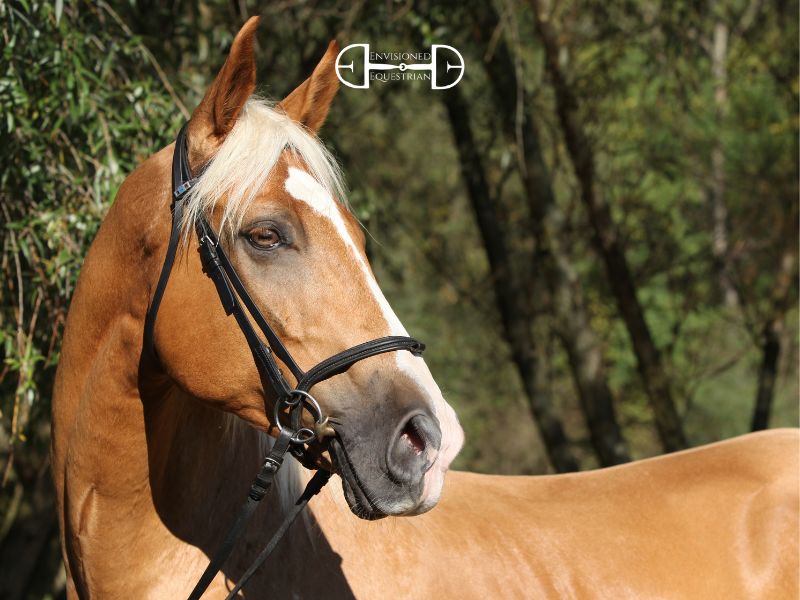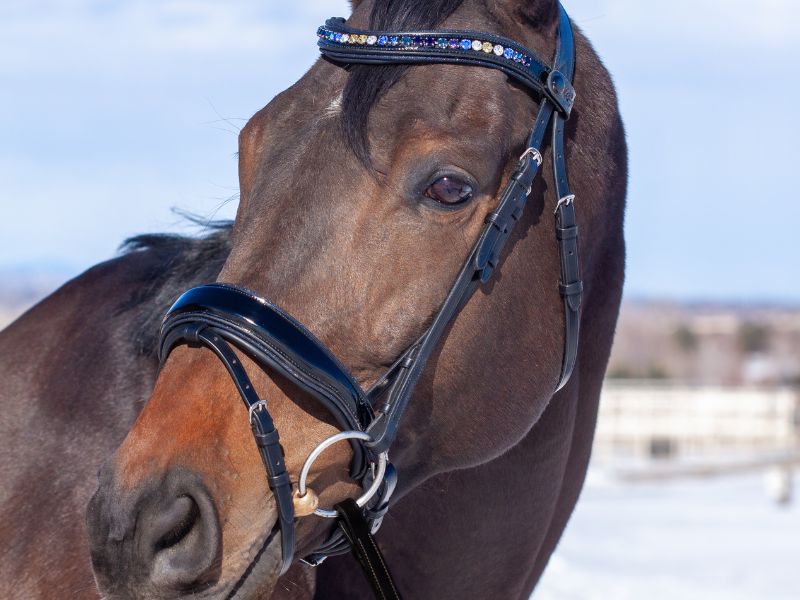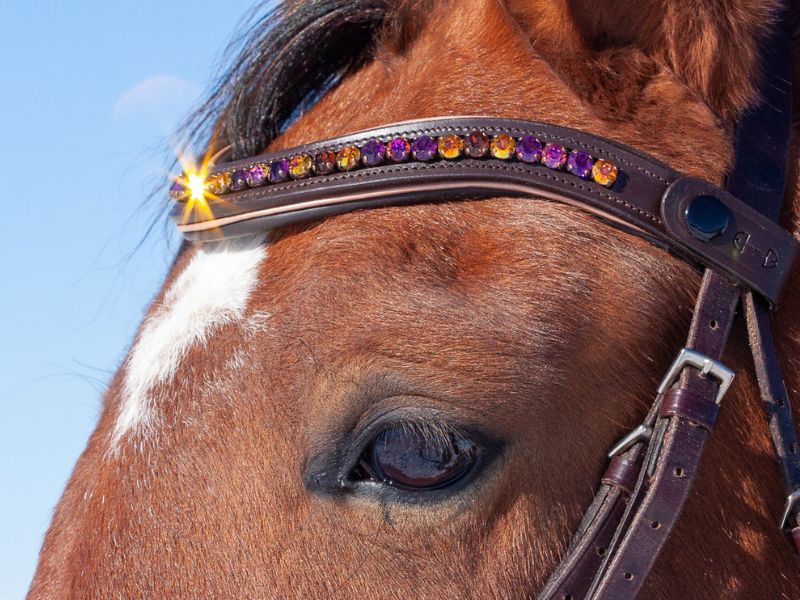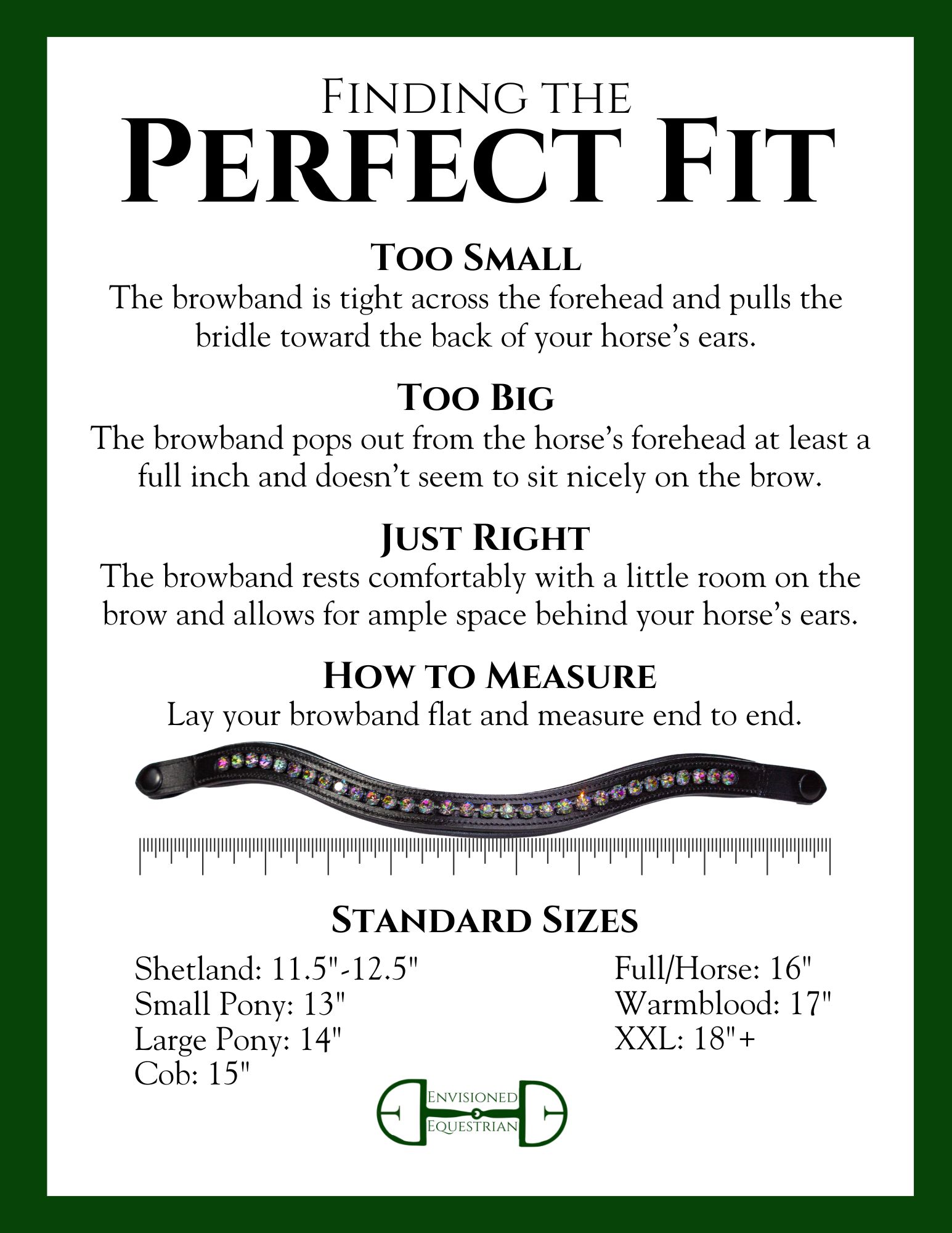
by LaceyKnight | Jan 18, 2025 | Bridle & Halter Fitting, Horses, Leather goods
I got all excited, and then they burst my bubble…with good reason.
In Need of an Anatomical Bridle
I have a friend with a horse who has a bone spur on his poll. The radiograph is disturbing; however, he can be ridden comfortably in the right tack.
She enlisted my help, and I jumped at the opportunity to create something for him. I began to draw and came up with what seemed like the perfect solution to this anatomical quandary. The design looked a lot like the Antares bridle but utilized less surface area so as to keep the pressure as localized yet well-distributed as possible.
Jumping at the Opportunity for a New Bridle
I was over the moon for this idea. I called my manufacturer and sent over the drawings. This would be possible. My heart leaped at the thought of creating something for all horses everywhere that could enhance their comfort while being ridden. I was so excited.
I had an order in the pipeline, so I got in there and changed all my bridles to a modified version of this new poll-relief design, whereby the padding would offer the poll and spine a channel of relief and more surface area for a more well-balanced crownpiece.
That Feeling You Get
I dreamt about it. I fantasized about how great this was going to be, and yet something nagged at me. I could not tell what this feeling was, but there in my gut it resided, and I knew something was wrong.
The same friend who needed the crown piece shared with me that the USEF had outlawed these poll-relief bridles for showing. I was perplexed. The design, in my mind, was absolute poetry. How could something that made the horse more comfortable, something more anatomical, be bad?
When I took the time to read the document, it made total sense. The weight of the entire bridle rests on the crown. When you divide up the padding or change how the crown sits, you induce uneven, increased pressure on both sides of the neck behind the poll. This may not be hugely impactful if you ride in a plain snaffle, but imagine how it might harm a horse if you ride in a double, or with training aids like side reins, draw reins, or a martingale. My big anatomical bridle bubble had burst.
I consulted one of my great friends who fits tack for a living. She didn’t even have a conversation with me. She just sent over the document for me to read. I understood. There was no getting around this. The poll-relief bridles, as they stand, are not in the horse’s best interest. You can read the USEF’s document here.
The Experimental Poll-Relief Bridle
Now, as for my friend in need, of course, we are moving forward with the experimental bridle for him. He is a special case, and we cannot overlook his bone spur that interferes with the crown of a normal bridle.
We need to offer him some relief.
The slightly uneven pressure will be a small price to pay for him. And bear in mind this is an experiment. We do not know if he will be rideable even with the modified bridle, but we are going to try for him.
Why Classical Bridles Outshine Some Modern Poll-Relief Bridle Trends
All of this is to say that trendy tack that is marketed well as anatomical, relieving of pressure, or ergonomic might not actually be so when it gets right down to the brass tack 😉
So, history wins when it comes to this particular argument. Classical is better than “modern” in this specific case.
If you want one of these new designs, I do advise against it. Let’s have a conversation about it. When you think about it for a brief moment, I feel like you, too, will come to the same conclusion that these bridles are not in the horse’s best interest.
In celebration of equines everywhere,
Lacey Knight
P.S. I did go back and undo the poll-relief crowns in my upcoming order. So the Rare Earth Elements Collection will feature normal, cutback, padded ergonomic crowns.
Need help with bridle fitting? Go here for an easy guide.

by LaceyKnight | Jan 14, 2025 | Bridle & Halter Fitting, Leather goods, Tack care
When it comes to equestrian equipment like rhinestone bridles and crystal halters, achieving the perfect fit is essential for both your horse’s comfort and performance. At Envisioned Equestrian, we believe that every piece—from brand-new luxury tack to your soft-as-butter ancient favorite—should not only look stunning but also fit seamlessly. Here’s a comprehensive guide to ensure your bridles and halters fit just right, keeping your horse happy and looking their best.
Why Proper Fitting Matters
An ill-fitting bridle or halter can cause discomfort, rubs, and even behavioral issues in your horse. A correctly fitted piece enhances communication and performance while showcasing your horse’s natural elegance. Whether you’re using a functional everyday halter or an exquisite rhinestone bridle, the right fit is non-negotiable.
Bridle Fitting Basics
1. Measuring for a Bridle
Start by measuring your horse’s head to determine the appropriate size. Most luxury bridles, including those at Envisioned Equestrian, are available in Cob, Horse, and Warmblood sizes. For custom measurements, focus on the:
- Browband: Should sit comfortably across the forehead without pinching behind the ears. A rhinestone browband, like our Winter’s Wake or Phoenix designs, adds sparkle while enhancing fit.
- Crownpiece: Should rest behind the ears without pressing on sensitive areas. Ergonomic designs are ideal for distributing pressure evenly.
- Cheekpieces: Adjust so the bit rests gently against the corners of the mouth, creating a soft wrinkle. Avoid over-tightening, as this can cause tension.
- Throatlatch: Leave enough space for four fingers between the strap and the horse’s jaw to ensure breathing is unrestricted.
2. Finding the Right Bit Position
The bit should sit evenly in the horse’s mouth, with no excessive movement. Check for proper bit fit by ensuring about 1/2 inch of space on either side of the mouth. Many horses have tongues that vary in thickness and cheeks that do so as well. When you fit a bit, you want to make sure you take these two things into consideration as well. If you like chunky bits, take a peek inside your horse’s mouth first to see how much room they have in there. Getting a big rubber bit may seem like a kind thing to do, but if they don’t have enough room in their mouth, it’s just as detrimental as getting a harsh bit that is uncomfortable for them.
3. Adjusting Nosebands
Nosebands should be snug but not tight. You should be able to fit two fingers underneath the band. This prevents discomfort and allows the horse to move its jaw naturally. Luxury bridles often feature padded or contoured nosebands for additional comfort. At Envisioned Equestrian, our nosebands take a few days to soften and bend to fit the horse’s face. Once it’s softened, you’ll have more room for adjustments.
Spotlight on Rhinestone Bridles
Rhinestone horse bridles are more than just functional; they’re a statement. Envisioned Equestrian’s collection features dazzling designs like the Twilight Tranquility or Sugar Plum browbands, perfect for adding a touch of glamour. When fitting rhinestone bridles, ensure the added embellishments don’t interfere with the horse’s movement or comfort. A well-fitted rhinestone bridle should frame your horse’s face beautifully while staying secure during work or play.
A properly fitted halter is crucial for daily handling and groundwork. Envisioned Equestrian’s crystal halters, such as the Glacial Waters Rhinestone Halter, combine elegance and practicality. Here’s how to ensure a perfect fit:
1. Adjusting the Crownpiece
The crownpiece should sit comfortably behind the horse’s ears. Opt for padded options to reduce pressure and enhance your horse’s comfort, especially during prolonged wear.
2. Finding the Right Noseband Fit
The noseband should rest about two fingers below the horse’s cheekbone. It should be snug enough to prevent slipping but loose enough to avoid pinching. Crystal horse halters with ergonomic designs offer a blend of fit and fashion, ensuring your horse stays comfortable while looking stunning.
3. Checking the Throatlatch
Ensure you can fit three fingers between the throatlatch and the horse’s jaw on a halter. This allows freedom of movement without compromising security.
Signs of a Poor Fitting Bridle or Halter
Whether it’s a bridle or a halter, look out for these red flags:
- Rub Marks or Hair Loss: Indicates excessive pressure or friction.
- Behavioral Issues: Head tossing, resistance, or discomfort during use may signal an improper fit.
- Uneven Wear: Check for imbalances, particularly in the bit or straps.
Addressing these issues promptly can prevent long-term discomfort or injury.
The Envisioned Equestrian Difference
At Envisioned Equestrian, we’re dedicated to creating rhinestone bridles and crystal halters that blend luxury and functionality. All our pieces are crafted with attention to detail, ensuring they’re as comfortable as they are stylish. Our custom sizing options mean every horse—from ponies to warmbloods—can enjoy the perfect fit.
Final Tips for Bridle Fitting Success
- Regular Checks: Horses’ shapes change over time. Reassess the fit of your bridles and halters periodically.
- Keep It Clean: Dirt and sweat can cause irritation. Clean your luxury bridles and crystal halters regularly to maintain both their beauty and functionality. Need help caring for your Envisioned Equestrian Leather? Go here.
- Seek Professional Help: If you’re unsure about the fit, consult a professional fitter or your trusted tack supplier.
When your horse’s equipment fits perfectly, they’re more comfortable, confident, and ready to shine—whether in the show ring or during daily rides. Explore Envisioned Equestrian’s stunning collection of rhinestone horse bridles and crystal halters to combine impeccable fit with unparalleled style.

by LaceyKnight | Dec 15, 2024 | Bridle & Halter Fitting, Leather goods
It’s time for a change.
When it comes to bespoke equestrian gear, it’s nothing if it’s not about the fit.
Most of the people I meet have a browband that’s too small.
It lays across the forehead, but it’s tight and pulls the crown of the bridle forward toward the ears. When it comes to browbands, extra space is key.
What if it sticks out from your horse’s forehead?
Two things: You want it to stick out slightly.
More than an inch or so might be too big, but you want your browband to be on the roomy side.
Second, if your handmade crystal browband sticks out a little, all the better for placing his forelock under it so everyone can then see the crystals glistening and gleaming in the light.
Here’s the deal when it comes to finding the perfect fit:

Envisioned Equestrian handmade horse browbands are generally crafted on the 1/2 inch.
We prefer to go up in size to help people get a good fit.
If your cob is currently wearing a 15 and you think it’s great, we suggest ordering a 15.5 or even a 16.
For example: We recently fit a horse who was wearing a cob-sized browband and the owner felt it was good.
This was a Quarter Horse, so they were not terribly big.
By the time I left, they were comfortably fit in a 17″, which looked great and gave them TONS of room to get that bridle sitting well behind the ears.
This QH wound up with a WB size, but that’s just how it goes sometimes.
Our personal rule of thumb: always go up in size if you’re comfortable doing so. You’ll be surprised at how happy your horse will be with a little extra “headroom.”
Shop your favorite styles here and order the size you need today!




